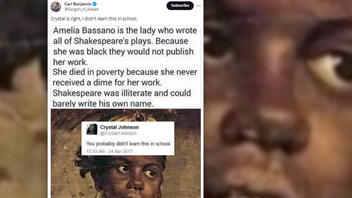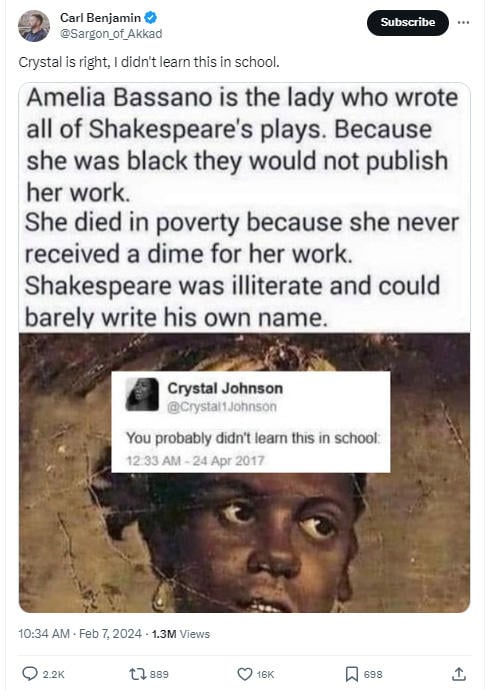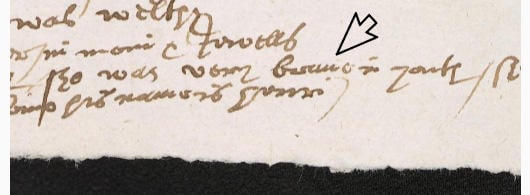
Did a 16th-century woman named Amelia Bassano write all of William Shakespeare's plays -- for which she "never received a dime" -- as she could not publish her own work because she was Black? No, that's not true: Bassano, who became Amelia Bassano Lanier through marriage, published her own volume of poems, in 1611. She may have had an olive skin tone, as her father was a musician from Venice, but there is no evidence that she was Black.
In the centuries since Shakespeare's death in 1616, theories, speculation and academic arguments have circulated claiming that he was not the author of works bearing his name. John Hudson, the founder of The Dark Lady Players in New York City and author of the book, "Shakespeare's Dark Lady: Amelia Bassano Lanier The Woman Behind Shakespeare's Plays?" proposed in 2009 that Amelia Bassano Lanier was the actual writer of Shakespeare's work. But Kate McLuskie, director of the Shakespeare Institute at the University of Birmingham, quoted in the Globe and Mail, said that Hudson's evidence is "a beautiful story that is not less beautiful for being entirely false."
The speculation continues in the 21st century: A meme claiming someone else wrote Shakespeare's plays resurfaced on February 7, 2024, in a post on X, formerly Twitter, (archived here). The post was captioned:
Crystal is right, I didn't learn this in school.
This is what the post looked like on X at the time of writing:
(Source: X screenshot taken on Fri Feb 9 14:59:32 2024 UTC)
The text of the meme reads:
Amelia Bassano is the lady who wrote all of Shakespeare's plays. Because she was black they would not publish her work.
She died in poverty because she never received a dime for her work.
Shakespeare was illiterate and could barely write his own name.
Was Amelia Bassano Lanier unpublished? No.
There is no evidence that Lanier worked as a ghostwriter for Shakespeare. In the January 15, 2010, article in the Globe and Mail titled "Was Shakespeare a woman?" (archived here) regarding Hudson's theory that Lanier may have been Shakespeare's writer, McLuskie is quoted:
John's evidence is entirely circumstantial, or depends on quasi-allegorical readings of the texts.
It is elegant and ingenious, but has no documentary foundation - a beautiful story that is not less beautiful for being entirely false.
Lanier published her own volume of religious poems, "Salve Deus Rex Judaeorum," in 1611. This was not done in secret or under a pseudonym, and the volumes contained many dedications to nobility, the presumption being that this was an effort to attract a patron. The title page of the book (digital copy available to check out online hourly) says:
Written by Æmilia Lanyer, Wife to Captaine
Alfonso Lanyer Servant to the
Kings Majestie
Do we know what Lanier looked like? No.
The meme pictured in the X post features a painting labeled "Portrait of a Moorish woman" attributed to a follower of painter Paolo Caliari. It was sold by Christie's in 2003. There is no evidence that this painting is in any way associated with the real Lanier or the "Dark Lady" of Shakespeare's sonnets.
A miniature painting by Nicholas Hilliard (full resolution here) dated 1593 is housed at the Victoria and Albert Museum in London with the generic title, "An Unknown Woman, aged 26." An inscription on the back, added at a later date in 19th-century handwriting, says this is "Mrs Holland Maid of Honor in the Court of Queen Elizabeth." In 2003, actor and playwright Tony Haygarth challenged this identification by proposing this was a portrait of Lanier. It should be noted that the date on the front of the miniature does not perfectly align with Lanier's age -- christened in January 1569, Lanier would not be 26 until 1595. At the time the portrait was painted she had been the mistress to the English nobleman Lord Henry Hunsdon and became pregnant. In 1592 Amelia Bassano married Alphonso Lanier. Her son Henry was born in 1593.
Lanier's father, Baptista Bassano, was from a Venetian family of court musicians -- it is possible that she had a Mediterranean complexion.
Do we know the identity of Shakespeare's 'Dark Lady'? No.
A secondary mystery exists intermingled with the question of whether Shakespeare had a ghostwriter, and that is "Who is the 'Dark Lady' featured in Shakespeare's Sonnets 127-152"? At least seven women including Lanier have been suggested as the inspiration for the woman described in Sonnet 130, which reads in part:
My mistress' eyes are nothing like the sun;
Coral is far more red, than her lips red:
If snow be white, why then her breasts are dun;
If hairs be wires, black wires grow on her head.
The historian A.L. Rowse wrote in "William Shakespeare: A Biography" (on page 197) in 1963:
All kinds of wild-cat notions have been proposed as to the identity of the Dark Lady. In fact we do not know, and are never likely to know, who she was; nor is this matter of much importance -- of more sentimental interest, than scholarly.
A decade later, Rowse thought he had made a discovery within the notes of a medical astrologer named Simon Forman, who kept detailed notes of his patients' visits in the late 1590s. Lanier went to him several times and many of the details known about her are derived from Forman's notes. On page 106 in his 1973 book "Shakespeare The Man," Rowse transcribes Forman's notes (a scan of the handwritten notes is here) from Lanier's visit to him on June 3, 1597) and then Rowse adds his own comment:
'She was maintained in great pomp. She is high-minded -- she hath something in her mind she would have done for her. She hath £40 a year [a good dowry for those days] and was wealthy to him that married her, in money and jewels. She can hardly keep secret. She was very brown in youth.'
Forman never notes this of anyone else: evidently she was exceptionally dark, to a degree that struck people.
(Source: Screenshot from "The casebooks of Simon Forman and Richard Napier, 1596-1634: a digital edition" taken on Mon Feb 12 22:33:44 2024 UTC)
However, this conclusion was faulty because Rowse misread the pen and ink script of Forman's casebook. The word that Rowse had interpreted to say "brown" (marked above with an arrow), was, according to Shakespearean scholar Stanley Wells, actually "brave." In a February 20, 1999, article in the Telegraph titled "Arguments over a woman" (archived here), Wells recounts his April 22, 1973, scholarly confrontation with Rowse on the air in a BBC radio interview. Wells wrote:
Reading Rowse's book late one night before the broadcast, I started to check his transcripts against the photographs of pages from Forman's notebooks. It was slow going. Forman's notes are scrappy and interspersed with cryptic astrological diagrams. I persevered, partly because I was puzzled by the phrase 'brown in youth.'
Emilia was, it seemed, only 27: had she gone prematurely grey? I was not surprised to find that the transcripts were riddled with error; scholars of Rowse's generation were often cavalier about this kind of thing. But when I came to the words that he had transcribed as 'brown in youth' I began to see that I was on to something.
To my eyes, the phrase was 'braue in youth.' It was difficult to be certain; the words came at the foot of a page, and looked rather dim in the photocopy. Still, I felt pretty confident, because 'brave' made better sense: it could mean 'fine,' 'showily dressed,' suiting Emilia's change in status from a courtesan to a married woman. It was only one word, but it was crucial, because on it depended the whole of Rowse's case that his Dark Lady was dark.
Shakespeare and a Russian 'troll factory'? Yes.
In the middle of the image in the post on X, there is a cropped caption from a now-deleted post (archived copy here) by @Crystal1Johnson, which was published on April 23, 2017. The timestamp discrepancy may have to do with the time zone of the person who took the screenshot. It says:
Crystal Johnson
@Crystal1Johnson
You probably didn't learn this in school:
12:33 AM-24 Apr 2017
The @Crystal1Johnson account, and this tweet, were part of the Russian Internet Research Agency "troll factory." The account was active from February 6, 2012, to August 24, 2017, posting a total of 8,081 tweets. The text of those tweets is preserved in a searchable database on russiatweets.com. Crystal Johnson was not the originator of the trope. This exact meme was debunked by Snopes on August 20, 2015.


















